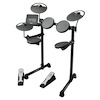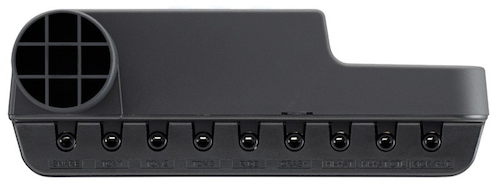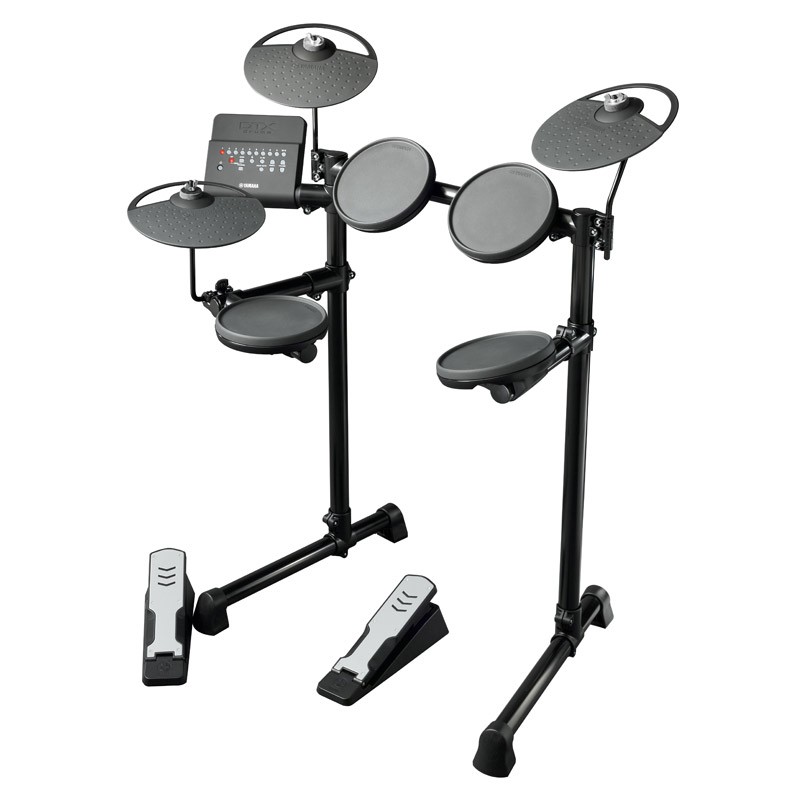YAMAHA DTX400K REVIEW
Posted on Tue 06 November 2012 in entries
 You can read more reviews like this, listen to Tony’s productions, purchase synth patches and more at his personal site -> Tony Long Music.
You can read more reviews like this, listen to Tony’s productions, purchase synth patches and more at his personal site -> Tony Long Music.
YAMAHA DTX400K - INTRODUCTION
If you have always thought that you would like to learn to play the drums in the privacy of your own home but you are restricted by how much noise you can make, you have probably considered purchasing an electronic kit. The trouble is, when you look at the kits available, they seem to either be too expensive or they don't really look like a full drum kit.
I am about to take a deep look at one electronic kit from Yamaha and one that is probably in the price range of most beginners - the DTX400K. It has been said that the DTX400K is an ideal starter drum kit, which is both compact and lightweight in its design. I want to determine its suitability and features for the new drummer starting out.
Whilst Roland are clearly the front runner in the world of Electronic Drums, I have always believed Yamaha do a better job of meeting the needs of the beginner. I have not heard or played the DTX400K but I am reasonably confident that Yamaha will have produced a product that not only sounds good, but makes the drums fun to learn at the same time, which after all, has got to be the best way to learn.
YAMAHA DTX400K - COMPONENT PARTS OUT OF THE BOX
Unpacking and assembling all seems to be very straightforward and the DTX400K is extremely well boxed and organised. This kit comes with a DTX400 Module with power supply (which is the drum brain that contains all of the sounds), a 7.5 inch snare drum pad and three 7.5 inch tom pads. There are also three 10 inch pads for the hi-hat, crash and ride cymbals. There is also a hi-hat foot pedal controller and bass drum pedal controller and it all assembles on the rack provided.
The black tubular metallic rack is fairly basic with two legs, a cross member, three main arms for drum pads and the module and three cymbal arms, one of which is for the i-hat cymbal. There is no bass drum or hi-hat as such, but instead there are two foot pedal controllers that simulate the feel of both a bass drum pedal beater hitting a head and the opening and closing of two hi-hat cymbals.
Yamaha have not released them yet but they intend to bring out two more kits in the DTX400 range in January 2013. These will have slightly better facilities and will be slightly more expensive but will provide the consumer with suitable choices to meet their needs and purse. However, all of the kits will also be upgradable, so you can grow your set-up as your skill and needs increase if you so desire. The two new kits will be the DTX430K and the DTX450K.
YAMAHA DTX400K - THE KITS, THE SOUND AND THE DRUM MODULE BRAIN
There are 10 drum kits on the DTX400K and all of them can be edited and overwritten. These kits all sound very good and provide you with all the sounds to fulfil all your basic drumming needs. Whilst you may think that 10 kits does not seem like very much, you need to appreciate that it is 9 more than the acoustic drummer who has bought their first kit to learn on.
Yamaha certainly know a thing or two about acoustic drums and have applied this knowledge in their selection. The 10 kits are as follows: a Yamaha Maple Custom, Yamaha Oak Custom, Hard Rock, Vintage, Funk, Session, Jazz, R&B, Marching and Percussion.
My favourite is a kit based on their very own Yamaha Maple Custom kit, which is a lovely warm, traditional wood kit. A friend of mine owns the acoustic equivalent and you can't help but love the sound it produces. They have complimented the drums nicely with an 18 inch crash cymbal, a 20 inch ride and 14 inch hi-hats, which all work well together.
The drum trigger module provides you with 169 high-quality sounds that Yamaha have taken from their professional DTX900, DTX700 and DTX500 kits, as well as from their excellent DTX-MULTI 12 electronic percussion pad. These 169 sounds provide you with a selection of 23 snare drums, 21 kick drums, 36 toms, 31 cymbals, and 42 percussion instruments and the 10 Preset kits that I have mentioned can all be overwritten so you can make your own custom kits.
The DTX400 brain is very lightweight for a module and it conveniently has the required attachment for you to quickly mount it on the stand. There is a snake for the cables and everything is labelled easily for instant connection. The cables are also made to measure to reach their particular drum without any untidy excess cable. This is good in one respect, but obviously makes it a little inflexible if you wanted alternative setups whereby the lead may not reach your new position. Generally I would say that this isn't a problem and could easily be resolved with a separate lead though.
 ](https://www.absolutemusic.co.uk/yamaha-dtx400k-electronic-drum-kit.html)
](https://www.absolutemusic.co.uk/yamaha-dtx400k-electronic-drum-kit.html)
The controls of the module are very straightforward and there are simply 21 buttons; no knobs, no LCDs; just buttons. To start with you have 10 buttons numbered 1 to 10 for you to select from the 10 drum kits, the 10 play-along songs or the 10 interactive training functions with the Vocal-Coach. Under this you have the Power button and then buttons to select Kit, Song, Training, Metronome, Start/Stop, Drum Mute and finally Tempo increase and decrease (30 to 300 BPM ) and Volume increase and decrease - how easy is that?
On one side of the module there are 9 mini-jack inputs for the four drums, 3 cymbals, bass drum and hi-hat controllers to connect to the module. On the other side are connections for USB to Host, Aux In, Headphone/Output and the 12V Power connection.
YAMAHA DTX400K - THE PADS, THE CYMBALS AND THE FOOT CONTROLLERS
So, the DTX400K kit was now all set up and I was ready to get going! As a drummer I found the it felt comfortable to play and the size of the kit was also good. However, I also tried to imagine what the DTX400K would be like to play from a beginner's point of view.
I would guess that there are both pros and cons to learning on an electronic kit. I remember hitting my 14 inch snare drum for the first time when I started to learn and it was almost as if I didn't want to hit it and when I did it did not make a particularly good sound. This is because after some time you realise that with an acoustic kit you have to 'make the sound', not just hit the drum in any fashion. The electronic kit on the other hand instantly gives you that 'recorded in the studio' sounding drum kit, which I guess could be viewed as both a good and a bad thing. However, the undoubted advantages of learning on the Yamaha DTX400K are that it won't wake the neighbours and with its 7.5 inch pads it will teach you to control your strikes and play more accurately.
The silent operation of the DTX400K extends to the new KU100 kick controller pedal and the hi-hat foot pedal controller. The cymbals and hi-hat are very playable 10 inch pads and respond well. The snare and tom pads are fairly hard but have been designed to give you a stick response that is similar to a real drum. Obviously at this price point they cannot capture every nuance of your playing like on more professional (and expensive!) kits, but at the same time they do a very good job and you can adjust the sensitivity to suit your own playing style. The other good thing here is that as your own playing skills develop, you can upgrade the pads. Perhaps the best upgrade you could do to start with is to upgrade the snare drum to Yamaha's three zone snare drum, giving you a sound on the pad, the rim and a cross stick sound as well as better dynamics.
YAMAHA DTX400K - SONGS AND DOWNLOADS
To get you used to playing drums in time with musical accompaniments, the DTX400K features 10 songs. You can mute the drums that are on each track or play along with them so you hear where things should go. To assist you further, you can slow the speed down and adjust the volume of the song. One of my favourite aspects here is that you can loop a section of a song so you can practice the most difficult parts over and over again until you get it right!
I remember my first attempt at drumming along to a song on the radio. I just hit any old drum whilst trying to stick to a rhythmical pattern! At the time I didn't care what sounds I was making and how 'wrong' my performance was, but I had great fun! However, as time went by I learnt the importance of simply listening to where bass drum and snare beats were placed and once the idea was in my head, I found I could do it - I wish I had a DTX400K back then!
 ](https://www.absolutemusic.co.uk/yamaha-dtx400k-electronic-drum-kit.html)
](https://www.absolutemusic.co.uk/yamaha-dtx400k-electronic-drum-kit.html)
We all like different styles of music and my friends could never understand the vast and varied musical styles that I drummed along with. I used to say to them that I liked to listen to rock music but quite often I would prefer to drum to a funk beat. Yamaha realise that you will probably learn quicker if you drum to music you like and have provided the facility to download via USB and over-write the 10 songs with ones of your choice. You can even add your own new MIDI song files into the module via their free Musicsoft Downloader.
Here is another useful tip: you can have the DTX400K drum module speak the current tempo to you as a BPM value. All you have to do is press and hold the metronome button and you will hear the current tempo spoken.
YAMAHA DTX400K - TRAINING MODE
I mentioned earlier that I thought Yamaha were great from an educational perspective and so I was very happy to discover from the manual that there is actually a very useful 'Training Mode'. The more I looked into it, the more in depth I realsed this mode was - you can use it for so much more than just getting you started!
Here is a summary of each option within the Training Mode:-
• 'Groove Check' is an aid to improving your timing, which uses the number button lights to show how early or late your hits are so you can see where to adjust your strokes.
• 'Rhythm Gate' training allows you to confirm by ear whether or not your timing is accurate. If you do not strike a pad in time, it will not produce any sound. This exercise connects your ears with your hands and feet so that your whole body works like a clock to keep solid timing whilst you are drumming
• The 'Measure Break' function is a popular training exercise that inserts a break into the click track for a number of measures. By setting the break for the measure(s) you play a fill-in, you can check for deviations in your timing when the click returns.
• You can use 'Tempo Up/Down' training to see how fast you can go and still maintain accurate timing. As you play along with the metronome, the drum module will automatically increase the tempo if your timing is good and decrease it if you need more practice playing in time - what an interesting idea this - you need to give this a go!
• In 'Change Up' training, your aim is to maintain good timing as you play along with up to seven different practice rhythms that change every two measures.
• 'Easy Session' training lets you play a drum pattern along with a complete practice song by simply striking any pad in time with the music. As such, it is not unlike a basic form of jamming with other band members and can help build confidence in beginner drummers.
• 'Groove Tracker' makes it easy to play a number of different practice patterns, which will automatically reflect the speed and strength of your drumming. In addition, you can also freely add your own fills to the basic pattern.
• In 'Pad Gate' training, the pads will only produce a sound when your drumming precisely matches a practice drum pattern and you hit the correct pad.
• 'Part Mute' training lets you mute any or all of the drum parts (i.e. hi-hat, snare, kick, tom, and/or cymbal) from an accompanying song and you can also mute the different band instrument parts.
• Lastly, in a 'Fast Blast' training session, you just play the drums as wildly as you can over a set period of time. More a game than a form of practice, your aim is to get the highest possible score.
As you can hopefully gather from these summaries, the Yamaha DTX400K is not just a fantastic beginner kit, but it also has a number of great features that will help more advanced drummers improve their trade.
YAMAHA DTX400K - MENU MODE WITH NO LCD
'Menu Mode' is used to set drum-module parameters and functions. Whilst holding the 'Kit' button, press the 'Song' button and you will switch on the 'Menu Mode'. The Number buttons 1 to 7 will start to flash. If you press one of these it will then take you through to the corresponding group: 1 = Metronome Settings, 2 = Kit Settings, 3 = MIDI Settings, 4 = Hi-hat Settings, 5 = Trigger Settings, 6 = Training Settings and 7 = Other Settings.
To be quite honest I was amazed at the number of parameters that you can change here (for a kit of this cost) and how simple it is to use without an LCD. The 'Trigger' settings for example, allow you to adjust Pad Velocity Curve, Crosstalk, Snare Pad Type, Pedal Types, Gain and Minimum Level.
 ](https://www.absolutemusic.co.uk/yamaha-dtx400k-electronic-drum-kit.html)
](https://www.absolutemusic.co.uk/yamaha-dtx400k-electronic-drum-kit.html)
YAMAHA DTX400K - WITH THE iPAD
What seems to be happening more and more today is that manufacturers are designing their products to not only communicate with PCs and Macs, but also with iPads, iPhones and now iPad Minis. Yamaha have recently become more involved with the making of iPad apps and are advertising their DTX400 series with two free apps, which assist in an educational way. One of them has video lessons to show basic drumming concepts, how you should hold the sticks, playing eight-beat groove and technique development for playing rock, jazz and other genres. They also have a Song Beats app with Song Shop, available for iPod, iPhone and iPod Touch, which comes with 10 demo songs. There are also over 3,000 songs that you can buy for this App, costing only £2 each.
YAMAHA DTX400K - CONTROLLING VSTs
With the USB-MIDI jack you can connect the Yamaha DTX400K to your computer to trigger VSTi drum sounds and also record into DAW software such as Cubase, Sonar, Ableton, Logic, etc.
YAMAHA DTX400K - CONCLUSION
The Yamaha DTX400K is a great kit to start learning to play drums. It is lightweight, very portable, very inexpensive, sounds great and it has quite a few features that do not immediately hit you when you first try it out. The drum module is incredibly easy to get to grips with and its simplicity keeps the cost down with no loss of functionality. The Song Player functions and the Training Mode make it a winner with the beginner and it gets even better when used in conjunction with Yamaha's iPad apps. You can also upgrade it with Yamaha's TP70S 3-zone snare pad, the XP-80 DTX-PAD snare and the FP110 belt-drive foot pedal, included with the KP65 kick pad. If you are currently thinking about learning to play the drums then my advice would be to get one of these today!
For more information on the Yamaha DTX400K, click the link below or give us a call on 01202 597180.
Yamaha DTX400K - More Info/Buy
Yamaha DTX400K & Accessories Bundle - SAVE £££s!!! - More Info/Buy
View our Complete Range of Yamaha DTX Electronic Drum Kits
http://www.youtube.com/watch?v=ZPzu9qiiszY
******If you're interested in buying and you have seen it cheaper elsewhere, please call us or use our
As well as receiving our first rate customer service you can also claim money off your next purchase with our loyalty points scheme and receive a 3 year warranty if you sign up to our FREE VIP Club (click here for more infomation). Many of our items also come out on a FREE next-day delivery service to mainland UK customers, so you won't be left waiting!
Also, if you want to keep up with all our latest offers, competitions, news and videos, why not follow us on Facebook and Twitter?


